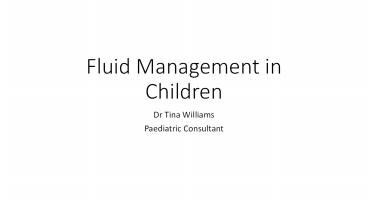Management of Fluids in Children - Nurses - PowerPoint PPT Presentation
Title:
Management of Fluids in Children - Nurses
Description:
Fluid Management in Paediatrics for Nursing Staff – PowerPoint PPT presentation
Number of Views:272
Title: Management of Fluids in Children - Nurses
1
Fluid Management in Children
- Dr Tina Williams
- Paediatric Consultant
2
Outline
- Fluid Distribution in Children
- Dehydration
- Overhydration
- Fluid Charts
- Electrolytes and Types of Fluids
- Specific Fluid Scenarios and calculations
3
Children ? Little Adults
- Total Body Water
- Neonates 80 85mls/kg
- 3kg baby, his blood volume is 240mls
- 10kg 1 year old, blood volume is 700mls
- Adults 60-75mls/kg
- 70kg man, blood volume is 4200-5000
- Dehydrate easily
- A small volume is a large proportion of
- intravascular space
- Fluid overload easily
4
Cardiac Arrest in Children
- What is the usual cause?
- Pump Failure
- Respiratory Failure
- Circulatory Failure
5
Cardiac Arrest in Children
- What is the usual cause?
- PUMP
- Respiratory Failure
- Circulatory Failure
6
Body Water
7
Measuring Dehydration
- 1000g in weight 1000mls
- Previous weight helpful to accurately say how
much weight/fluid lost - 5 Dehydration
- 5/100 x 1000mls x Weight
- 50mls/kg
- In a 10kg child
- 500mls
8
Shock
- Inadequate organ perfusion
- Usually from
- inadequate intravascular fluid volume
(hypovolaemia) - Gastroenteritis with severe dehydration
- Burns
- Blood loss in trauma
- fluid in the wrong body compartment
(maldistributed) - Sepsis
- Intra-abdominal pooling obstruction, infarction
- Nephrotic Syndrome
- Treated separately and urgently before addressing
dehydration
9
Overhydration
- Not as common
- Children with
- Renal Failure
- Heart failure
- Or
- Excessive intravenous fluids
- Maldistribution Nephrotic syndrome, Sepsis with
vascular leak, Neonates after Hypoxic ischaemic
episode
- Remember the fluid has to pool somewhere!
- Peripheral Tissues facial puffiness, dependent
oedema - Lungs Pulmonary Oedema
- Heart Congestive failure
- Brain Cerebral oedema
10
Insensible Losses
- We often Forget about this
- Not seen
- Sweat
- Respiration
- Measured as output in addition to what is seen
- 500mls/m2
- Increased by 12.5 for every degree increase in
temperature over 380C - Increased on a hot ward, hot weather!
- Increased with increased Resp rate
11
What we need to do as Medical Staff
- Recognise signs of Fluid loss or overhydration
- Monitor fluid intake/ Output
- Measure urine output accurately weigh nappies
if necessary - Remember NGT drainage or other drains!
- Be aware of Insensible losses
- Dont just record a beautiful fluid balance
chart, Take action!
12
What Should a Fluid Chart Look like?
13
Remember
- Input includes
- IV Fluids
- Drinks
- Oral meds
- Soups
- IV antibiotics
- Flushes
- Output Includes
- Stools
- Urine
- Vomits
- Drains
- Insensible Losses at top of daily chart
- Frequency of summary depends on how ill child is.
- 4 12 hourly And action!
- Weights 12 hourly
14
Replacing Fluids
- Calculations
- Maintenance
- Deficit
- Ongoing Losses
- Route
- Oral Best unless contraindicated
- NGT
- Intravenous
15
Electrolytes
- Hypertonic or Hyperosmolar plasma
- Fluid shift from tissues to plasma
- (Brain is major organ)
- Sodium
- Hypernatraemia Hypertonic/ Hyperosmolar
- Hyponatraemia
- Potassium
- Hypokalaemia
- Hyperkalaemia
- Glucose
- Hyperglycaemia Hypertonic/ Hyperosmolar
- Hypoglycaemia
16
Types of Fluids
- Oral Hydration Satchets/ Solution
- Flat Coke/ Apple Juice
- 0.9 Saline
- 0.9 Saline / 5 Dextrose
- 0.9 Saline / 10Dextrose
- 10 Dextrose
- Additives Na (2-4mmols/kg/day),
- K (1-2mmols/kg/day)
- Hartmans
- 4.5 Human Albumin Solution
- Blood
- 3 Saline
- Breast Milk
17
Specific Scenarios
18
Healthy Child admitted pre-op
- Maintenance Fluids
- Isotonic Fluids
- Additives Na, K if electrolytes normal
- Calculations for 24 hrs fluids
- 100mls/kg 1st 10kg
- 50mls/kg 2nd 10kg
- 20mls/kg every kg afterward
- Divide total by 24 to give mls/hr
- Use0.9 Saline/5 Dextrose
19
Gastroenteritis
- Calculate
- Maintenance Fluids Backgound 0.9 saline/5
Dextrose - Deficit Assess degree of dehydration and
replace deficit over 12-24 hours - Ongoing losses volume of each vomit or lose
stool
- Keep an eye on balance closely especially in
small infant or if frequent loose stools - Hyper or Hyponatraemic dehydration
- Secretory diarrhoea
- Oral rehydration or NGT best!
- Wean IV as oral intake increases
20
Diabetic Ketoacidocis
- Watch out for signs of Cerebral oedema as you
treat! - Calculate Deficit Divide by 48hrs
- Calculate Maintenance Divide by 24 hrs
- Give the total hourly over 48hrs
- Monitor Electrolytes/ Glucose closely
- Treat Shock 10mls/kg aliquots
- Maintenance as usual over 24 hrs
- Replace deficit over 48 hours
- Dont start insulin till an hour of hydration
- Start with 0.9 Saline Swap to 0.9 Saline/ 5
Dextrose once Glucose 11-14mEq/L - Add K to bag as soon as Insulin started
21
Renal
- Nephrotic Syndrome
- Look puffy and gain weight but intravascular
space depleted - Lose albumin in urine
- Plasma Oncotic pull is low and fluid leaks out of
vessels
- 8 12 hourly input/output
- Weigh daily
- Monitor pulse, capill refill and BP
- Urinary Na indicates need for fluid/albumin bolus
- Fluids Maintenance Previous day output
Insensible losses
22
Questions?































